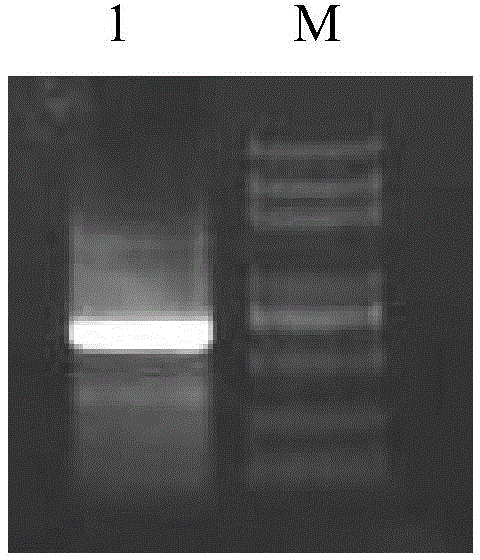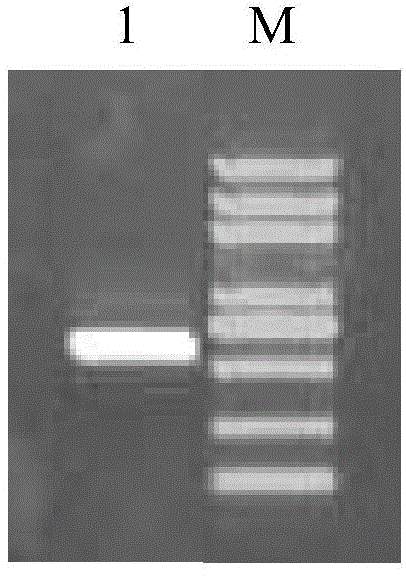Cold resistance correlated protein from leymus chinensis, encoding gene thereof and application thereof
A coding and gene technology, applied in the field of genetic engineering, can solve problems such as complex response mechanism, hinder large-scale application, and difficult to specifically enhance cold resistance, and achieve broad application prospects, improve cold resistance, and high application value.
- Summary
- Abstract
- Description
- Claims
- Application Information
AI Technical Summary
Problems solved by technology
Method used
Image
Examples
Embodiment 1
[0070] Example 1. Obtaining the full-length cDNA sequence and genome sequence of the cold resistance-related gene Lc3919 of Leymus chinensis
[0071] 1. Cloning of the 5' end sequence of Lc3919, a gene related to cold resistance of Leymus chinensis
[0072] 1. Plant material processing and total RNA extraction
[0073] Leymus chinensis (Trin.) Tzvel.) variety Zhongke 2 (recorded in "XXLi, SLHou, QGao, et al. LcSAIN1, novell salt-induced gene from sheepgrass, conferssalt stress tolerance in transgenic Arabidopsis andrice. One article, the public can obtain from the Institute of Botany, Chinese Academy of Sciences) seedlings as materials, extract total RNA after low temperature stress (4°C) treatment for 12 hours, and carry out 1% agarose gel electrophoresis detection, the results are as follows figure 1 shown. The extracted RNA has two obvious electrophoresis bands, which are 28SRNA and 18SRNA from top to bottom, indicating that the total RNA with higher purity and integrity ...
Embodiment 2
[0092] Example 2. Expression pattern and tissue specificity analysis of Lc3919 gene under stress conditions
[0093] The seedlings of Leymus chinensis variety Zhongke No.2, which had grown normally for 5 weeks, were subjected to low temperature stress (4°C). The stress treatment time was 0, 1, 2, 4, 8, 12, 24, 48 hours, respectively. The total RNA of Leymus chinensis seedlings treated above was extracted, and the expression pattern of Lc3919 gene under low temperature stress was analyzed by qRT-PCR method. Wherein the amplified Lc3919 gene primer sequence is 5'-CATCTTCTTCCTCAGCGCAC-3' (position 511-530 of sequence 2) and 5'-GACTCATCCTCCACATCGCCG-3' (reverse complementary sequence of position 604-623 of sequence 2); Actin was used as an internal reference gene, and the primer sequences for amplifying the internal reference Actin were 5'-GTGCTTTCCCCTCTATGCAAGTGGT-3' and 5'-CTGTTCTTGGCAGTCTCCAGCTC-3'; two-step PCR amplification standard procedure: 95°C for 10s; 95°C for 5s, 60°C...
Embodiment 3
[0097] Example 3, the subcellular localization of the Lc3919 gene
[0098] The Lc3919 gene amplified in Example 1 above (positions 1-907 of sequence 2) was connected to the pMDC45 vector containing GFP through a recombinant LR reaction (recorded in "Mark Curtis, Ueli Grossniklaus, et al. Agateway cloning vectorset for high-throughput functional analysis of genes in planta. (2003). PlantPhysiology 133:462-469." article, the public can obtain from the Institute of Botany, Chinese Academy of Sciences) between the recombination sites attR1 and attR2, the resulting recombinant expression vector was named pMDC45-Lc3919. The structure of the recombinant expression vector pMDC45-Lc3919 is described as: a recombinant plasmid formed by inserting the DNA fragment shown in nucleotides 1-907 of Sequence 2 in the sequence listing between the recombination sites attR1 and attR2 of the pMDC45 vector.
[0099] The recombinant expression vector pMDC45-Lc3919 was introduced into Agrobacterium tu...
PUM
 Login to View More
Login to View More Abstract
Description
Claims
Application Information
 Login to View More
Login to View More - R&D
- Intellectual Property
- Life Sciences
- Materials
- Tech Scout
- Unparalleled Data Quality
- Higher Quality Content
- 60% Fewer Hallucinations
Browse by: Latest US Patents, China's latest patents, Technical Efficacy Thesaurus, Application Domain, Technology Topic, Popular Technical Reports.
© 2025 PatSnap. All rights reserved.Legal|Privacy policy|Modern Slavery Act Transparency Statement|Sitemap|About US| Contact US: help@patsnap.com



